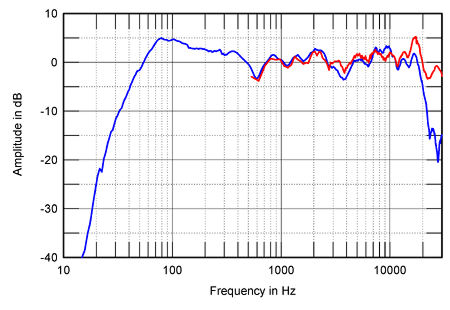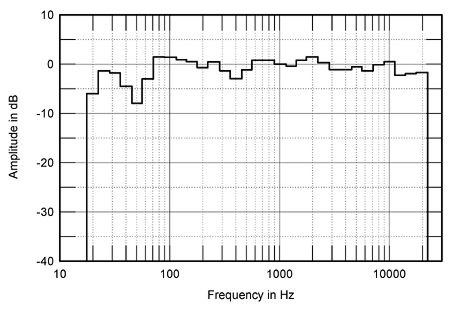| Columns Retired Columns & Blogs |
MartinLogan Montage loudspeaker John Atkinson June 2005
John Atkinson wrote about the Montage in June 2005 (Vol.28 No.6):
Kalman Rubinson was quite taken last month with MartinLogan's affordably priced ($1495/pair) Montage loudspeaker. The floorstanding Montages produced a spacious-sounding, well-defined stereo image, he found, along with a seamless transition between its short ribbon tweeter and the pair of reflex-loaded, metal-cone woofers, and a surprisingly extended bass. However, he was bothered by a lack of low-frequency dynamic range and an upper bass that began to sound gruff when the speaker was handling high levels of complex music, with a "lower-midbass emphasis that overwhelmed the taut extension at the very bottom."
Kal blamed this character on the Montage's cabinet, which vibrated significantly at high playback levels. When I measured the speaker I indeed found some severe cabinet resonances, at 277Hz and 360Hz, as well as a lower-level mode at around 500Hz. However, these are a little high in frequency to affect the upper-bass region; to investigate further, I set up the Montages in my own listening room for some serious auditioning. Amplifiers were Mark Levinson No.33H monoblocks driven by a Levinson No.380S preamp, a No.30.6 D/A processor, and a No.31.5 CD transport. Line-level cabling was all balanced—AudioQuest Cheetah between the source components, Madrigal between pre and power amps—while speaker cable was AudioQuest Kilimanjaro.
For various reasons, I ended up using the MartinLogans for about three weeks. During much of that time, I enjoyed what the speakers did. The soundstaging was indeed well-defined, though with a bit of a splash to the sides in the mid-treble. Like Kal, I found the Montage's treble a trifle forward. There was a bit of mid-treble emphasis, and although this was quite subtle, I felt the two speakers differed slightly in this respect. While this contributed to the sense of the Montage sounding detailed, it did add some hardness at high playback levels to the male voices on Morten Lauridsen's transcendentally tonal "O magnum mysterium," from Comfort and Joy: Volume One, my 2004 recording of Cantus singing Christmas music (CTS-1204).
The speaker's top end was smooth but a little mellow, which, in conjunction with the uncolored mids, made classical piano recordings sound very natural. However, when the piano was already balanced on the forward side, as in the Living Stereo re-release on SACD of Artur Rubinstein's 1954 performance of Brahms' Piano Concerto 1 (RCA Red Seal 82876-66378-2), the sound became a bit too clangy.
It was in the lower registers that the Montage failed to live up the promise of its midrange and treble. The lowest notes of Hyperion Knight's Steinway on Rhapsody (CD, Stereophile STPH010-2) sounded a bit gruff, a little disconnected from the piano's upper registers. Similarly, the lowest notes of Jerome Harris' bass guitar on Rendezvous (CD, Stereophile STPH013-2) didn't quite speak with the same clarity as it did higher in frequency, even at modest playback levels.
Like Kal, I found that the Montage reached its dynamic limits sooner than I was anticipating. During the review period I was working on a new recording of Cantus, Comfort and Joy, Volume Two, the second part of the choir's Christmas music project, due for release in the fall. On one track, the African "Betelehemu," the singers are accompanied by a battery of percussion, including two djembes of different size. The djembe is a relatively small drum held between the player's knees; it is basically designed to be a bass "cannon," producing an enormous wash of low frequencies when struck. Asked to reproduce these drums, the Montage lost definition, blunting the attack and reducing the differentiation of the drums' pitches.
Was it the cabinet resonances that were muddying the sound? When I auditioned the half-note-spaced toneburst track on Editor's Choice (CD, Stereophile STPH016-2), while I could hear the coloring effect of the resonances mentioned above, they were definitely in the lower midrange rather than the upper bass—too high in frequency to explain what Kal and I heard. A mystery.
Measurements: I did perform a couple of additional measurements while I had the speakers in my home. First, I compared the responses of both samples, averaging their farfield outputs across a 30º horizontal window centered on the tweeter axis. The results are shown in fig.1. The response of the sample measured for the May issue is shown in blue, that of the other one of the pair in red. The pair matching is quite good, though the latter does have a flatter output through the mid-treble, as well as more energy above 15kHz.

Fig.1 MartinLogan Montage, anechoic response on tweeter axis at 50", averaged across 30º horizontal window and corrected for microphone response, with the complex sum of the nearfield LF responses, taking into account acoustic phase and distance from the nominal farfield point, plotted below 300Hz. Samples MTPF 0084 (red) and 0085 (blue).
Fig.2 shows the Montage's spatially averaged response in my listening room, assessed by taking 120 individual 1/3-octave spectra for the left and right speakers separately, with the microphone positioned in a rectangular grid centered on the position of my ears. Arranging the Montages, with their vertically spaced woofers, at optimal distances from the room boundaries was more tricky than usual; I never could eliminate the slight lack of midrange energy apparent in this graph. Apart from that, however, the Montage's in-room balance was superbly flat, meeting ±1.3dB limits from 450Hz to 11kHz. The slight energy excess at 2kHz correlates with the forward treble Kal and I noted in our auditioning, but given that, if anything, the Montage's output in the 10kHz region is a little high, I am at loss to explain why I thought the speaker mellow-sounding. Perhaps I was being misled by the speaker's grain-free HF presentation.

Fig.2 MartinLogan Montage, spatially averaged, 1/3-octave response in JA's listening room.
The low-frequency behavior in fig.2 is dominated by the room acoustics—the suckout at 63Hz is characteristic of my room. If I move my chair forward, this suckout fills in, but at the expense of an even deeper suckout in the 50Hz region, which makes the low-bass sound disconnected. But note that the Montage does produce respectable levels in-room between 25Hz and 40Hz, reflecting the 32Hz tuning of the rear-mounted port and the reinforcement of its output by the adjacent room boundaries.
Summing Up: From my own experience of this speaker's sound quality, I think Kal called it correctly. However, at just under $1500/pair, the MartinLogan Montage is relatively inexpensive, considering its high standard of fit'n'finish, its relatively neutral tonal balance, and its extended in-room low frequencies. In smaller listening rooms, its limited dynamic range may well not be an issue.—John Atkinson
- Log in or register to post comments




































